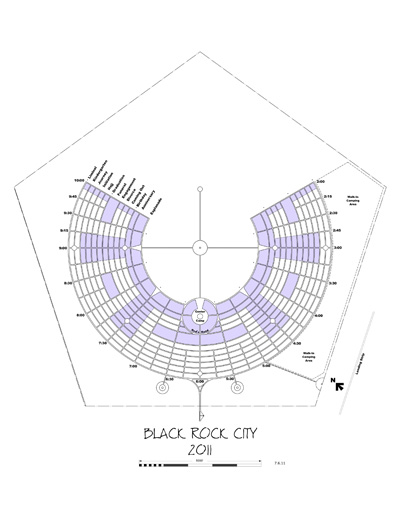[UPDATED BELOW] Black Rock City LLC, the SF-based company that stages Burning Man in the Nevada desert, was placed on probation by the Bureau of Land Management after exceeding the 50,000-person population cap at last year’s event, jeopardizing its current efforts to get a five-year permit and adding a new pressure to an already difficult transition year.
“Probationary status limits the Bureau of Land Management to issuance of a one-year permit,” said Cory Roegner, who oversees the event from BLM’s Winnemucca office. His office put BRC on probation after it reported populations of 53,341 on Sept. 2 and 53,735 on Sept. 3, although BRC has appealed the ruling to the Interior Board of Land Appeals, which has not issued a ruling.
Representatives from that office and BRC have not yet returned Guardian calls for comment.
Roegner has been working on finalizing the Environmental Analysis of BRC’s proposal for a five-year permit that would allow the event to gradually increase from 58,000 to 70,000 participants. A draft report was released in March, and Roegner is now working on responses to the 40 comments that were received during the 30-day comment period, with the final report expected to be released the first week in June.
At that time, the BLM office would set the population limit for this year’s event and issue the permit. But if the BLM probation ruling isn’t overturned, that permit would be for just this year. And under BLM rules, if BRC violated its population cap again this year, it could be banned from holding events in the future.
“Population is a very important issue. That’s a big focus of the environmental analysis on which the permit is based,” he told us, referring to the 2006 study that placed the current 50,000 cap on population.
This places BRC in a precarious position given that it has already sold 57,000 tickets for this year’s event and will be giving away thousands more to staff, groups that have received art grants, and a host of other visitors and VIPs (last year, three members of the Board of Supervisors attended and Mayor Ed Lee is rumored to be mulling a trip this year).
Roegner and his boss at the BLM, Rolando Mendez, say it’s up to BRC to live by its permit. “Black Rock City LLC is free to sell as many tickets as they’re inclined to,” Mendez told us in February. “That’s a calculated business decision on their part, but I would expect Black Rock City LLC to live by the population cap that I set.”
In fact, despite the fact that tickets have already been sold, it’s possible that Burning Man won’t even get a permit this year, although that’s very unlikely and both BRC and BLM have said they have a good, cooperative working relationship. The environmental report studies alternatives that include no event, maintaining the current 50,000 population cap, and gradually increasing it to 70,000, with a 58,000 cap this year.
Roegner said the report (which you can read here in PDF form) and its comments identify traffic and transportation, air quality, and trash as key issues that could require additional mitigation measures, but he said it was still too early to determine exactly what that will mean for Burning Man and its participants.
Burning Man, which started on Baker Beach in 1986 and moved to the the Black Rock Desert in 1990, seems to be suffering from its own success. Last year, the event sold out for the first time and this year a new ticketing system proved problematic and sparked widespread criticism. But BRC officials have maintained that they’re addressing the problems and creating systems to ensure the long-term survival of the event and culture it has spawned.
4/46 UPDATE: BRC spokesperson Marian Goodell responded to our inquiries via text message, downplaying concerns over probation and the population issues. Initially, she wrote that probation “won’t effect 5-year permit process,” and when we noted that Roegner said it would limit BRC to a one-year permit, she wrote, “We are still continuing the 5-year permit process. The probation is under appeal.”
We asked how BRC plans to abide by this year’s population cap given that it has already sold or distributed more tickets than the number of people allowed by the permit, she wrote, “Easy. Usually at least 6,000 leave before we hit the peak. Sometimes more on dusty, wet or cold years.”
Yet Ron Cole, who lives on a ranch near the event site and made comments during the EA process, was critical of BRC for defying BLM controls and trying to substantially increase the size of Burning Man. “They should just give them a one-year permit and 50,000 cap,” he told us, citing the event’s impacts on air quality and limitations on getting people on and off the playa. He was dubious about BRC’s behavior this year: “You can sell tickets, bill credit cards, and you don’t even have a permit yet?”

